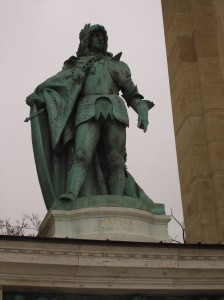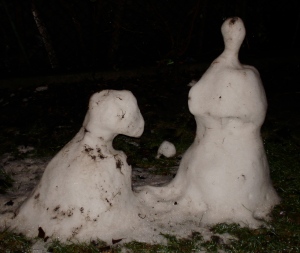In honor of the sesquicentennial of its release, I read Darwin’s On the Origin of Species by Means of Natural Selection (for some reason I prefer the full title to the more common Origin of Species). I finished about a month ago, but have put off writing about it until now.
I will not be writing a book review, teaching evolution, or debating it. Many others have done so. I’m just getting down a few of my thoughts about the book and evolution in general, as well as some things that I learned while reading it.
Evolution by any other name
The first thing I learned is that the term Natural Selection comes from the term Selection which is defined as man purposefully (and sometimes unconsciously) selecting desirable traits and breeding those animals or plants to produce better offspring. This would likely have been a much more common concept at that time when more people were involved in agriculture. Also, Darwin never uses the word evolution (though interestingly he uses the word revolution 4 times in different contexts). Instead he uses a phrase that I found quite charming: descent with modification.
A quaint breakthrough
One of the first things that I noticed is how old it seems. I know that may seem obvious, but many of the things he wonders about we simply take for granted. For example, he doesn’t understand why animals vary within a species, and he is unable to explain how breeds often “revert” to characteristics that haven’t been present for up to 20 generations. He uses the analogy of mixing blood, but realizes it doesn’t work. Instead he comes to the conclusion that:
When a character which has been lost in a breed, reappears after a great number of generations, the most probable hypothesis is, not that the offspring suddenly takes after an ancestor some hundred generations distant, but that in each successive generation there has been a tendency to reproduce the character in question, which at last, under unknown favourable conditions, gains an ascendancy.
I suppose this may have been deep insight for his day, but I wanted to scream back in time that it was simply a recessive trait. I wanted to explain genetics to him (Darwin was apparently unaware of the work of Mendel his contemporary). His ignorance serves to make his discovery even more amazing. If someone were to explain genetics and DNA and all the other advances that have been made in this area in the last 150 years he would probably smack himself in the forehead and say, “Duh, everything makes sense now.” (At least it’s fun to imagine a Victorian Charles Darwin with his huge beard saying “Duh”.)
I felt that the book was important for me because it made me realize how people thought before certain things were discovered. I tend to have a hard time remembering how I thought before I knew something. (e.g. How did I look at the world before I learned about differential equations? or What did I believe before I believed in evolution? Was there ever such a time?) Reading On the Origin of Species served to remind me that our current ways of thinking will soon seem quaint. And that’s a good thing to remember.
What we haven’t learned
Darwin spends a good deal of effort explaining that the concept of a species is inherently fuzzy. At the time many naturalists were concerned with whether two beings belonged to different species or were merely different varieties (or breeds) of the same species. He goes to great lengths to point out that there isn’t really a difference between a species and a variety–it’s all a matter of degree. Species are not distinct entities, rather individuals form a continuum of variation (though of course it’s not really a continuum since there are finitely many different genetic codes less than a fixed length). This is one lesson that I think we haven’t learned very well in that last 150 years, or at least that I didn’t learn. I’m sure biologists understand this, and perhaps if you had asked me I could have told you, but I didn’t conceptualize it that way. My mental model of species was of them being separate and distinct.
Darwin spends several chapters dealing with the difficulties of the theory. He discusses the imperfection of the geological record (which has improved significantly since his time) as a potential problem, as well as how seemingly complex things like instinct and eyes could possibly have come about in this manner (Hint: as long as each step along the way is beneficial it can work). He discusses several aspects of hybridism which I found interesting but am not qualified to discuss (you’ll have to read about them yourself–it’s not too difficult to read).
Religion
Sadly, I feel that I must address the topic of religion. This section should be considered optional reading unless you are a creationist or interested in the evolution-religion debate. I wish that this weren’t necessary, but until the majority of people are at least willing to consider that evolution might be true (and stop pushing for creationism to be taught in science class), I think we’ll have to keep talking about it.
In my mind one of the most compelling evidences for descent with modification over creation is the geographical distribution of species. Why, as Darwin points out, would marsupials only be found in South America and Australia (and nearby islands) if they were created by God? Why would cave fish be more closely related to their non-cave neighbors than to cave fish in other places who share nearly identical environments?
Some creationists have proposed that God made fossils and planted other evidence for evolution to force us to have faith. I cannot believe this. God is not a liar. Or if he is, maybe he doesn’t deserve to be called God.
In any case, which is more miraculous, a God who can create a static world of well-defined species or a God that can set things in motion which will, after millions of years, give rise to a vibrant, varied and beautiful planet (dare I say universe)? If one truly believes that God is omnipotent then surely he could create a universe that will lead to any given set of “species” by the end (or by the middle for that matter). In other words I see no reason to believe that God can create man in his own image, but only if he does it all at once. Who am I to say that God isn’t powerful enough to use evolution to create life if he wants to?
In case you are wondering, the LDS church officially has no position on evolution and teaches it at church schools, but in my experience many members seem to believe that the church’s position is against evolution. This is doubtless due in part to several statements made (unofficially) by some leaders back in the days when the church forbade birth control and interracial marriage. The Mormon church, so fond of eternal progression, should be the first to embrace descent with modification as a wonderful analog and teaching aid.
I suspect most Mormons who reject evolution in favor of creationism do so because they fear giving in to the world (intellectualism). The problem is that in doing so they give in to fundamentalist christianity and a literal reading of the bible, which I personally believe is a much greater threat to Mormonism in the short term. I would be happy if Mormon leaders would follow the lead of the Catholics and officially accept that evolution can be compatible with Christianity, but I’m afraid that doing so might cause some who believe in creationism too much to become disaffected.
Hopefully, Mormons and fundamentalist christians will eventually come to accept evolution, just as they have accepted heliocentrism (I don’t have much hope for people like the Flat Earth Society).
Sidenotes
A recent Radiolab episode discusses, among other things, the work of Dmitri Beliaev, a geneticist in Stalinist Russia. In order to escape certain death for being a Darwinian (incidentally doesn’t Stalin killing evolutionists prove it’s true :-), he started a fox farm in Siberia. He kept the most “domesticated” foxes and used the rest for fur coats. After only 10 years the foxes were noticeably domesticated. It turns out it may be because domesticated foxes are more juvenile in a very real sense (to find out more you’ll have to listen–it’s worth it). So perhaps when Jesus said for of such is the kingdom of heaven
and Isaiah said The wolf also shall dwell with the lamb
they were speaking about the same thing.
Many people feel that Darwin was greatly influenced by reading Adam Smith’s An Inquiry into the Nature and Causes of the Wealth of Nations (I really like the long titles), and that in fact it may have been Smith’s theory which led to Darwin’s breakthrough. If you think about it the theory is the same in both cases: many small, selfish decisions taken together can create a (locally) “good” system. This is why I find it ironic that many people are religiously devoted to free market economics and against evolution. It’s a good thing I no longer believe in the inherent rationality of our species.
Read Full Post »
 Hungary has this cheese called Turos that the Hungarians are in love with. Most often you see it in Turorudi – a refrigerated chocolate covered candy that you can buy almost anywhere. You can also get it in pastries (it’s really good) and apparently you can buy it at the store because I found some yesterday and I bought it. It’s kind of like cottage cheese, but not as regular in shape and without the runny stuff between the curds I guess. It tastes a little like cottage cheese, but not really. It’s pretty hard to explain, really. But I bought a bag of it yesterday and then had to figure out what to do with it. We ate a little bit on bread and it was pretty good that way, but sometime last night it hit me – muffins! It would be good in muffins!
Hungary has this cheese called Turos that the Hungarians are in love with. Most often you see it in Turorudi – a refrigerated chocolate covered candy that you can buy almost anywhere. You can also get it in pastries (it’s really good) and apparently you can buy it at the store because I found some yesterday and I bought it. It’s kind of like cottage cheese, but not as regular in shape and without the runny stuff between the curds I guess. It tastes a little like cottage cheese, but not really. It’s pretty hard to explain, really. But I bought a bag of it yesterday and then had to figure out what to do with it. We ate a little bit on bread and it was pretty good that way, but sometime last night it hit me – muffins! It would be good in muffins!









